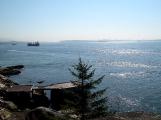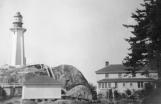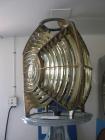1
Mercury Baths, Aladdin Lamps, and Radio BeaconsTechnology
Guiding Lights
Lighthouses have provided safety to mariners ever since sailors have ventured to sea. The first warning beacons consisted of wood and coal fires mounted on coastal points. These early aids to navigation had several shortcomings as they were exposed to wind and consumed a lot of fuel. In the nineteenth century, the design and construction of lighthouse developed into a highly specialized branch of engineering. Towers come in many shapes and sizes and generally resemble symmetrical tree trunks to minimize resistance to wind and waves. Typically they are not more than 200 hundred feet above water level - anything higher is difficult to see.
2
The eastern view from the Point Atkinson lighthouseAugust, 2004
Point Atkinson, West Vancouver, British Columbia, Canada

3
Over the years, technological innovations have been applied to improve light stations and provide a variety of services for marine safety. Fresnel lenses, compressed air foghorns and later, electricity contributed to safety on the seas. Radio beacons and other navigational aids complemented the lights and foghorns in guiding mariners.4
Changes in technology greatly changed the life of the light keeper. Radio and helicopters eased the isolation. Electricity and diesel generators replaced steam and kerosene reduced the amount of manual labour required but increased the sophistication of the skills and knowledge required to operate and repair the machinery. In the 1990s, automation removed many light keepers from lighthouses.5
Postcard of Point Atkinson Lighthouse.1910
Point Atkinson, West Vancouver, British Columbia, Canada

6
The LightWhile lighthouse towers are popular landmarks, it is the light that is important to the mariner. By the time lights came to the coast of BC in the 1860s, catoptric and dioptric systems of illumination were in use.
Catoptric lens
The catoptric lens system operated on the principle of reflection. A highly shiny metal surface was placed behind a lighthouse to direct the light. The first light at Point Atkinson worked on the catoptric principle and used two coal oil lamps that would run for eight hours. The reflector was made out of silver plated copper that was cleaned and polished every day.
7
1st order Fresnel lens used in lighthouse in Chilang, China.1910
Chilang, China
 Credits:
Credits:Courtesy of Elaine Graham.
8
Dioptric lensBy the time the current tower was built in 1912, a Frenchman, Augustin Fresnel, revolutionized the science of the lighthouse lens. Fresnel designed a system that condensed the light into a horizontal beam. He took a central piece of glass-the bull's eye-and constructed a number of concentric rings of class around it. By bending-or refracting-the light rays in a desired direction, the dioptric lens concentrated and focused a very weak light into a bright and powerful beacon.
Dioptric lenses are classified into seven main groups or orders. First order lenses are the largest and most powerful. The dioptric lens at Point Atkinson in 1912 was a third order lens and would show two flashes every five seconds. During the day, a canvas curtain covered the housing for the lens so sunlight did not refract off the prism and create a fire hazard.
9
The pilot's station (foreground) and the Point Atkinson lighthouse and keeper's duplex (background).1940
Point Atkinson, West Vancouver, British Columbia, Canada

10
The year [Grafton] took over, the entire station was transformed. The old dwelling and tower were torn down. Colonel Anderson sized upon the publicly accessible site to show off his latest concrete design-a hexagonal tower embraced by six buttresses-an adroit combination of aesthetics and function which always evokes a chorus of 'oohs' and 'aahs' and 'far outs' from those who climb the Lighthouse Viewpoint and see it for the first time soaring up from below. The steam engines were thrown piece by piece into the chuck and a new fog alarm building was constructed to house internal combustion engines, air compressors, and diaphones.- From Don Graham, Keepers of the Light, 1985, pp. 71-72.
11
Weights from Point Atkinson Lighthouse.2004
Point Atkinson, West Vancouver, British Columbia, Canada

12
The light mechanism weighed approximately 1600 pounds. It floated in a 400 pound mercury tank. A clockwork system turned the lens. A cable with weights ran the height of the tower and was wound up when the weights reached the bottom. Until an electric motor was installed in 1963, the light keeper had to wind up the weights ever 2 ½ hours-the time it took the weights to reach the bottom of the tower.13
Prism from Point Atkinson Lighthouse.2004
Point Atkinson, West Vancouver, British Columbia, Canada
